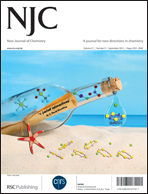Ruthenocene-containing β-diketones, RcCOCH2COR with Rc = ruthenocenyl and R = C10F21 (1), CF3 (2), C6F5 (3), C10H21 (4), CH3 (5) and C6H5 (6), were synthesised by Claisen condensation of the appropriate methyl ester with acetylruthenocene, and their spectroscopic, electrochemical and thermal properties were compared. A new synthetic route utilising 1,2,3-benzotriazol-1-ylethanone (9) or 1,2,3-benzotriazol-1-yl(ruthenocenyl)methanone (10) as a reactant, rather than the conventional esters, was found to be more efficient for β-diketone synthesis. The apparent acid dissociation constants, pKa′, of the new ruthenocene-containing β-diketones are 7.14(4) (1, R = C10F21), 9.92(3) (3, R = C6F5) and 10.06(2) (4, R = C10H21). Peak anodic potentials of the ruthenocenyl group of 1–6, pKa′ values and the FTIR ν(C![[double bond, length as m-dash]](https://www.rsc.org/images/entities/char_e001.gif) O) stretching frequencies of the precursor esters, RCOOCH3, correlated linearly with the Gordy scale group electronegativity, χR, of the C10F21 (χC10F21 = 3.04), C6F5 (χC6F5 = 2.46), C10H21 (χC10H21 = 2.43) and other R-groups. An electrochemical study in the non-interacting solvent and electrolyte system CH2Cl2/0.1 mol dm−3 [N(nBu4)][B(C6F5)4] revealed electrochemically irreversible one-electron transfer Rc/Rc+ couples in the potential range 650 < Epa < 1110 mV. Strikingly, reduction of the unstable monomeric 17 electron species, [Rc+(C5H5)(C5H4COCH2COR)], was clearly observed for all β-diketones possessing fluorinated R-groups, even at slow (100 mV s−1) scan rates. The enol isomer of the fluorinated β-diketones had >90% abundance under the conditions of study and the first order rate constant of enol to keto conversion varied between 220 and 50 000 s−1 depending on solvent (CDCl3 or CD3CN) and R-groups. Thermal analysis (DSC) of 1 and 4 showed no liquid crystalline mesophase behaviour but definite polymorphism was observed. β-diketones 1 and 4 exist as low temperature polymorphs below 42 °C or 12 °C respectively. The high temperature polymorphs converted to isotropic liquids at 83 °C (compound 1) or 52 °C (compound 4).
O) stretching frequencies of the precursor esters, RCOOCH3, correlated linearly with the Gordy scale group electronegativity, χR, of the C10F21 (χC10F21 = 3.04), C6F5 (χC6F5 = 2.46), C10H21 (χC10H21 = 2.43) and other R-groups. An electrochemical study in the non-interacting solvent and electrolyte system CH2Cl2/0.1 mol dm−3 [N(nBu4)][B(C6F5)4] revealed electrochemically irreversible one-electron transfer Rc/Rc+ couples in the potential range 650 < Epa < 1110 mV. Strikingly, reduction of the unstable monomeric 17 electron species, [Rc+(C5H5)(C5H4COCH2COR)], was clearly observed for all β-diketones possessing fluorinated R-groups, even at slow (100 mV s−1) scan rates. The enol isomer of the fluorinated β-diketones had >90% abundance under the conditions of study and the first order rate constant of enol to keto conversion varied between 220 and 50 000 s−1 depending on solvent (CDCl3 or CD3CN) and R-groups. Thermal analysis (DSC) of 1 and 4 showed no liquid crystalline mesophase behaviour but definite polymorphism was observed. β-diketones 1 and 4 exist as low temperature polymorphs below 42 °C or 12 °C respectively. The high temperature polymorphs converted to isotropic liquids at 83 °C (compound 1) or 52 °C (compound 4).
![[double bond, length as m-dash]](https://www.rsc.org/images/entities/char_e001.gif) O) stretching frequencies of the precursor
O) stretching frequencies of the precursor 

 Please wait while we load your content...
Please wait while we load your content...